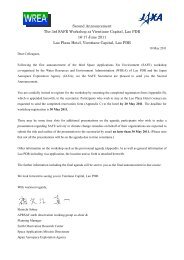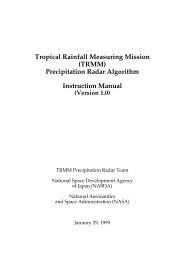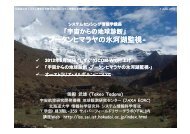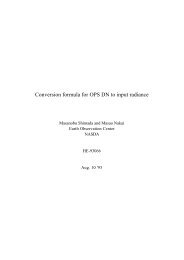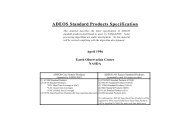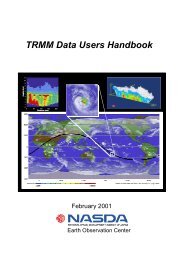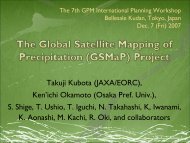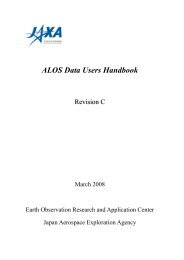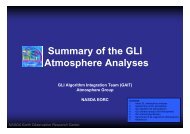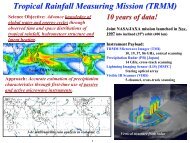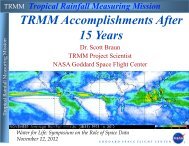4.12.2a_Tibet_Wu Guoxiong Tibet-CEOP.ppt[]
4.12.2a_Tibet_Wu Guoxiong Tibet-CEOP.ppt[]
4.12.2a_Tibet_Wu Guoxiong Tibet-CEOP.ppt[]
- No tags were found...
Create successful ePaper yourself
Turn your PDF publications into a flip-book with our unique Google optimized e-Paper software.
Optimum Observation Sites<br />
over the <strong>Tibet</strong>an Plateau for Understanding<br />
the Asian Monsoon and Its Impacts<br />
WU <strong>Guoxiong</strong><br />
LIU Yimin, LIU Xin , MAO Jianyu and DUAN Anmin<br />
State Key Lab of Atmospheric Sciences and Geophysical Fluid<br />
Dynamics (LASG)<br />
Institute of Atmospheric Physics (IAP)<br />
Chinese Academy of Sciences (CAS)<br />
ICTP, Trieste, June 10-15, 2001
References:<br />
1. <strong>Wu</strong> <strong>Guoxiong</strong>, Yongsheng Zhang, 1998: <strong>Tibet</strong>an Plateau Forcing and<br />
monsoon onset in South Asia and Southern China Sea. Mon. Wea. Rev.<br />
1998, 126(4): 913-927.<br />
2. <strong>Wu</strong>, <strong>Guoxiong</strong> and Yimin Liu, 2003: Summertime quadruplet heating<br />
pattern in the subtropics and the associated atmospheric circulation.<br />
Geophys. Res. Lett., 30(5), 1201, 5_1-4.<br />
3. YIMIN LIU, GUOXIONG WU, AND RONGCAI REN, 2004: Relationship<br />
between the Subtropical Anticyclone and Diabatic Heating. J. Climate, 2004, 17:<br />
682-698.<br />
4. <strong>Wu</strong>, <strong>Guoxiong</strong>, Yimin Liu, Jianyu Mao, Xin Liu and Weiping Li. 2004: Adaptation<br />
of the atmospheric circulation to thermal forcing over the tibetan plateau.<br />
Obseervation, Theory And Modeling Of The Atmospheric Variability. Selected<br />
Papers Of Nanjing Institute Of Mateorology Alumni In Commemoration Of<br />
Professor Jijia Zhang, Edited By Xun Zhu Etc.World Scientific 92-114.<br />
5. Yanai, M, and <strong>Wu</strong> <strong>Guoxiong</strong>, 2005: Effects of the <strong>Tibet</strong>an Plateau . To appear as<br />
Chapter 13 in Asian Monsoon, Edited By Bin Wang Etc.World Scientific.
Atmospheric Thermal adaptation<br />
(i)<br />
PV-θ View- Latent heating<br />
(ii) Friction impact- Surface sensible<br />
heating<br />
(iii) Sensible heat driven air-pump over<br />
TP (SHAP)
z 3<br />
z<br />
T<br />
θ 3<br />
P<br />
D P<br />
D t<br />
1 v v ∂ θ<br />
= ζ<br />
a<br />
⋅ n<br />
ρ<br />
∂ z<br />
1 v 1 r<br />
= Fζ<br />
⋅ ∇ θ + ζ<br />
a<br />
⋅ ∇ Q<br />
ρ<br />
ρ<br />
z 2<br />
z 1<br />
z 3<br />
z<br />
Q<br />
A<br />
B<br />
S<br />
T<br />
θ 2<br />
θ 1<br />
θ 3<br />
(a)<br />
z 2<br />
A<br />
θ 2<br />
(b)<br />
N<br />
2<br />
W<br />
≅<br />
Q<br />
z 1<br />
Q<br />
B<br />
S<br />
A 1<br />
θ 1<br />
1<br />
S<br />
∫<br />
Pdm<br />
=<br />
θ<br />
θ<br />
T<br />
∫ ζ<br />
B<br />
an<br />
dθ<br />
z 3<br />
z 2<br />
z 1<br />
z<br />
Q<br />
T<br />
A<br />
B<br />
S<br />
θ 3<br />
θ 2<br />
A 1<br />
θ 1<br />
(c)<br />
z 3<br />
z<br />
T<br />
θ 3<br />
z 2<br />
A<br />
θ 2<br />
(d)<br />
z 1<br />
Q<br />
B<br />
S<br />
A 1<br />
θ 1
Summertime Eurasian Continental Heating<br />
and<br />
<strong>Tibet</strong>an Plateau LOCAL Heating
<strong>Tibet</strong>an<br />
July<br />
气 压 (hPa)<br />
气 压 (hPa)<br />
Rockies<br />
July<br />
Andes<br />
January
a) Without<br />
mountain<br />
b) With<br />
mountain<br />
b) –a)<br />
Jul
Atmospheric Thermal adaptation<br />
(i)<br />
PV-θ View- Latent heating<br />
(ii) Friction impact- Surface sensible<br />
heating<br />
(iii) Sensible heat driven air-pump over<br />
TP
Ertel Potential Vorticity Equation<br />
PV:<br />
v<br />
P = αζ<br />
a<br />
W ρP<br />
= a<br />
⋅ ∇θ<br />
; (1)<br />
v<br />
= ζ ⋅ ∇θ<br />
. (2)<br />
PV equation:<br />
Advection form:<br />
∂P<br />
P V P F<br />
a Q<br />
t<br />
+ v<br />
⋅ ∇ = v<br />
=<br />
∂<br />
⋅ ∇ + v<br />
& α θ αζ<br />
⋅ ∇ . (3)<br />
Divergence form:<br />
dW ∂W<br />
VW F a Q<br />
dt t<br />
+ ∇ ⋅ v<br />
= v<br />
=<br />
∂<br />
⋅∇ + v<br />
θ ζ ⋅∇<br />
. (4)<br />
Dissipation<br />
Heating
Atmospheric Thermal Adaptation<br />
_<br />
+<br />
+<br />
Negative Vor- flux<br />
Negative Vor- source
1<br />
3<br />
5<br />
7<br />
9<br />
11<br />
13<br />
15<br />
17<br />
19<br />
1<br />
5<br />
7<br />
9<br />
3<br />
Atmosphere<br />
tmosphere<br />
Ocean<br />
cean<br />
.008916<br />
1<br />
2<br />
3<br />
Land<br />
and<br />
.074074<br />
.188615<br />
.336077<br />
.500000<br />
.663923<br />
.811385<br />
.925926<br />
.991084<br />
500<br />
680<br />
900<br />
25<br />
75<br />
125<br />
180<br />
255<br />
360<br />
1160<br />
1455<br />
1775<br />
2115<br />
2475<br />
2850<br />
3235<br />
3625<br />
4015<br />
4405<br />
4800<br />
GOALS/LASG.IAP CLIMATE MODEL<br />
Sea Ice<br />
Sun
(a)<br />
4 8<br />
Surface sensible heating results in negative<br />
vorticity input into the atmospheric volume<br />
from the underlying ground surface.
Atmospheric Thermal adaptation<br />
(i)<br />
PV-θ View- Latent heating<br />
(ii) Friction impact- Surface sensible<br />
heating<br />
(iii) Sensible heat driven air-pump over<br />
TP (SHAP)
Jul.<br />
Jan.
NCEP monthly mean of 10m wind & 500 hPa ω
V and w at σ=0.991
θ 2<br />
θ 1<br />
Pumping<br />
θ 2<br />
θ 1<br />
Pumping<br />
θ 2<br />
θ 1<br />
No Pumping<br />
U, w and θ vertical cross- section
Impacts of SHAP<br />
on<br />
Summertime Circulation
Impacts of SHAP<br />
on<br />
Asian Monsoon Onset
May<br />
Jun<br />
Jul
V. Concluding remarks<br />
1. The circulations forced by TP local thermal forcing and by<br />
continental scale heating in summer are in phase. Wet<br />
monsoon to the east and dry climate to the west of the<br />
Continent are therefore intensified by TP.<br />
2. TP in summer is a huge source of negative vorticity.<br />
3. TP Air- Pump is driven by surface sensible heating (SHAP),<br />
which regulates the surrounding climate and affects the world<br />
circulation<br />
4. One of the functions of the TP SHAP is to anchor the Asian<br />
summer monsoon onset over the region from eastern Bay of<br />
Bengal (BOB) to western Indochina Peninsula.<br />
5. The Optimum observation sites should be on the slopes,<br />
particularly the S- and SE- slopes, of the <strong>Tibet</strong>an Plateau.
THE END<br />
THANK YOU!


![4.12.2a_Tibet_Wu Guoxiong Tibet-CEOP.ppt[]](https://img.yumpu.com/35802437/1/500x640/4122a-tibet-wu-guoxiong-tibet-ceopppt.jpg)
